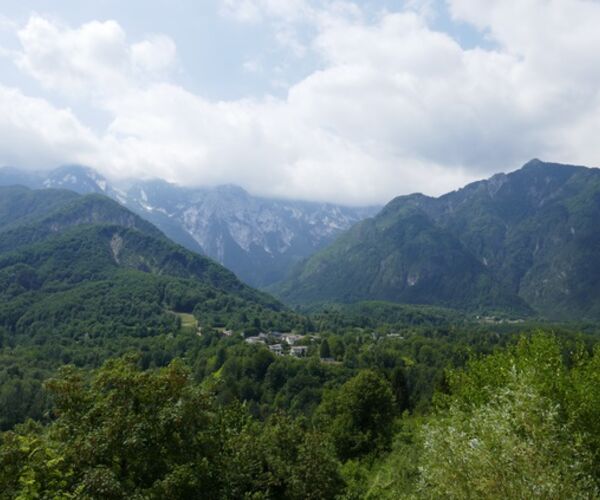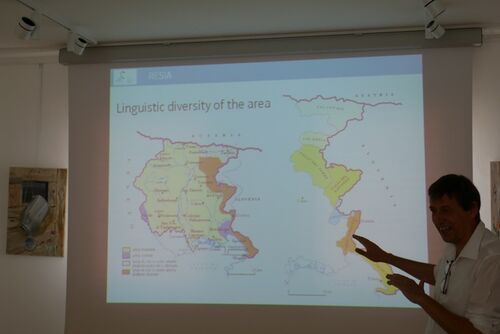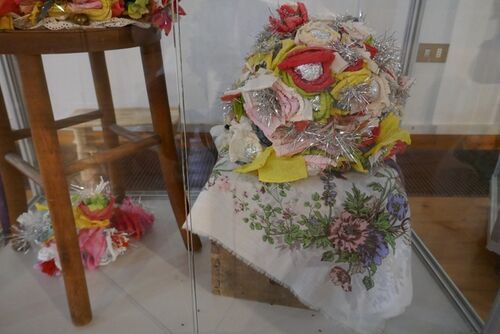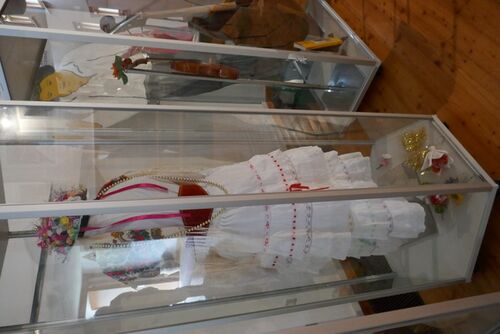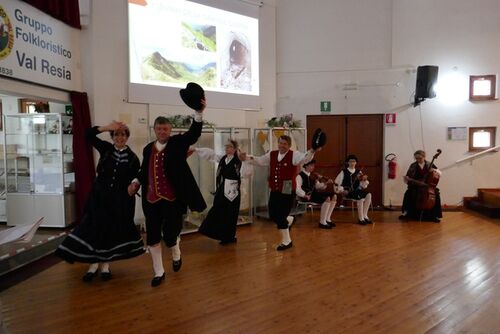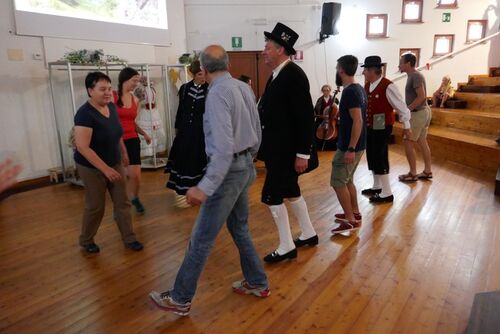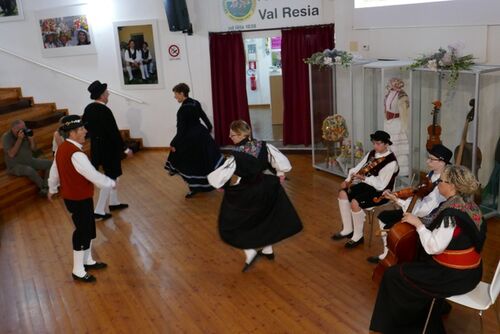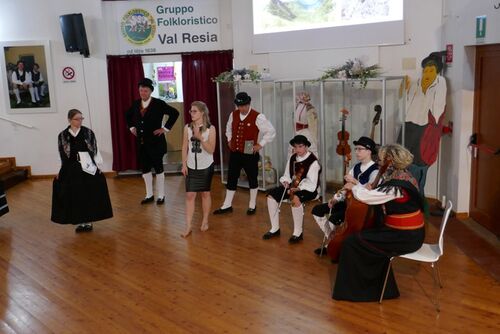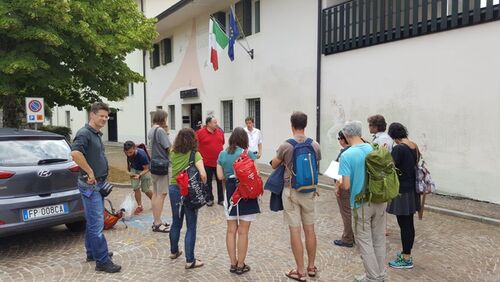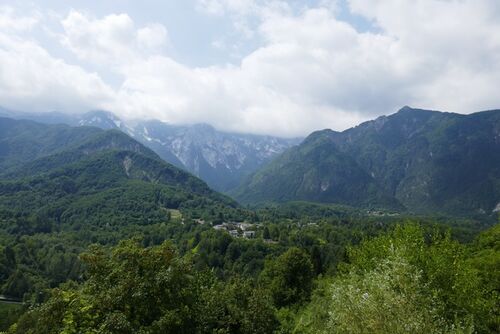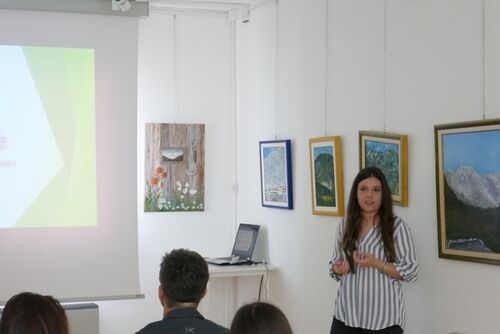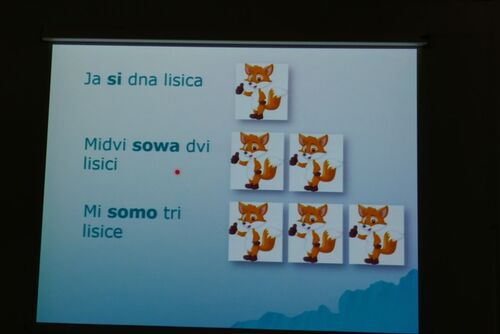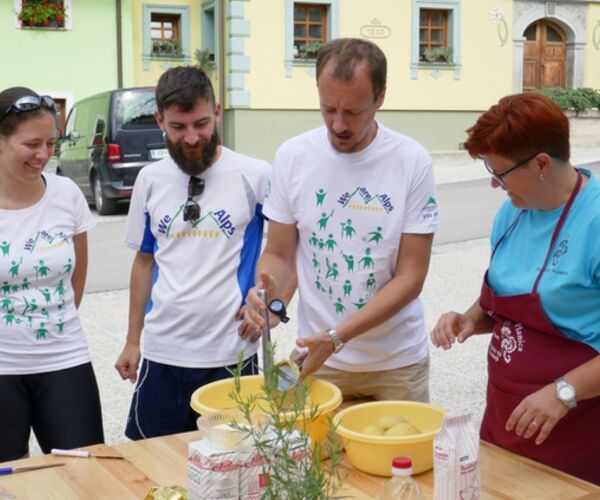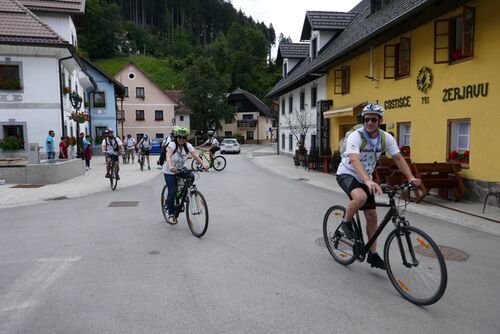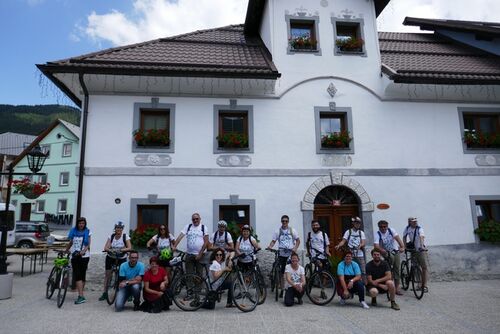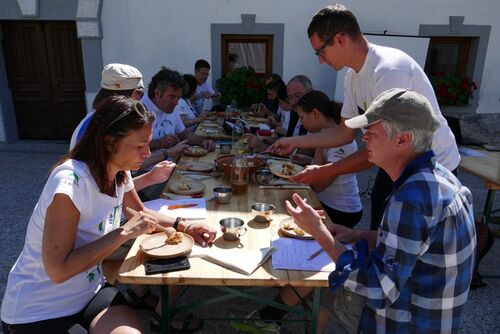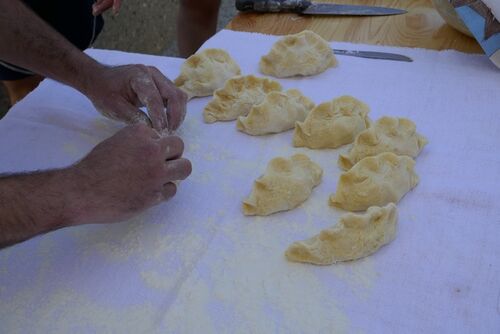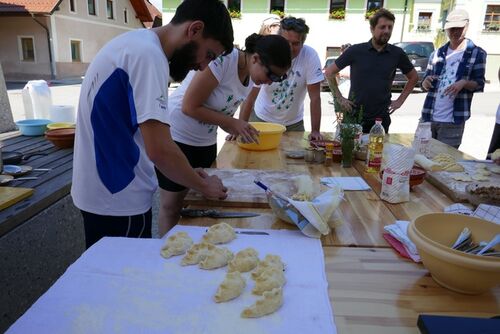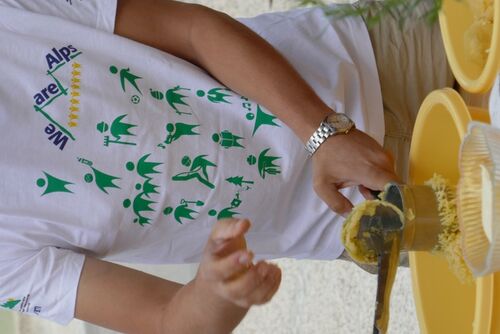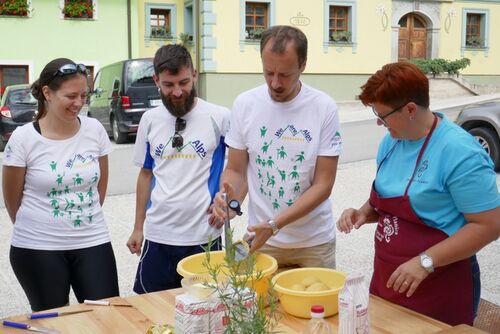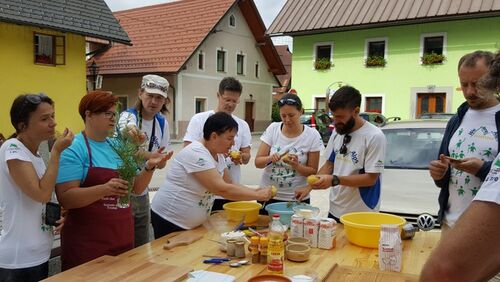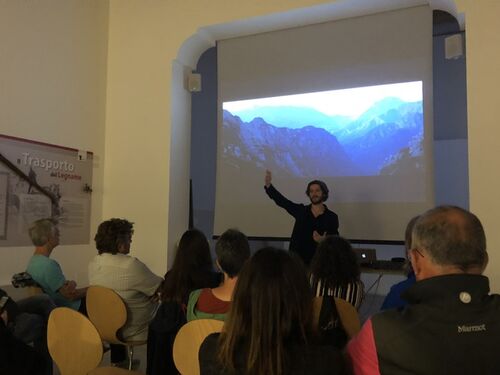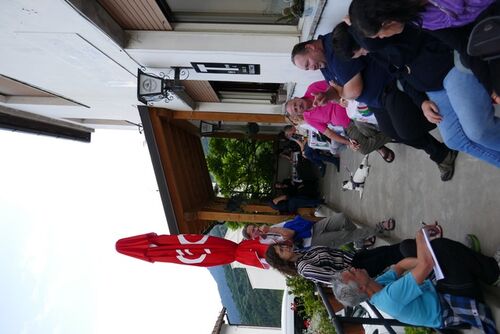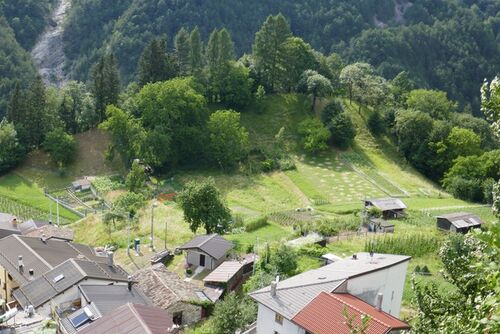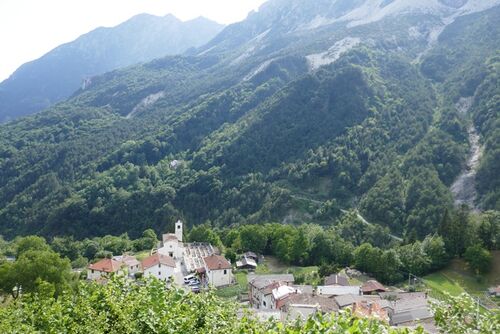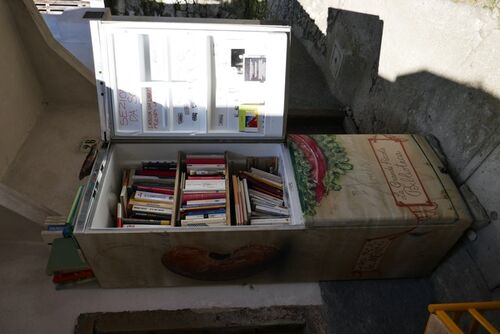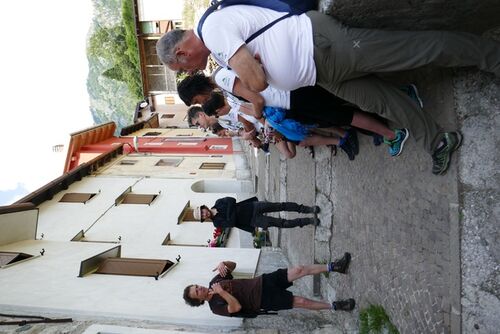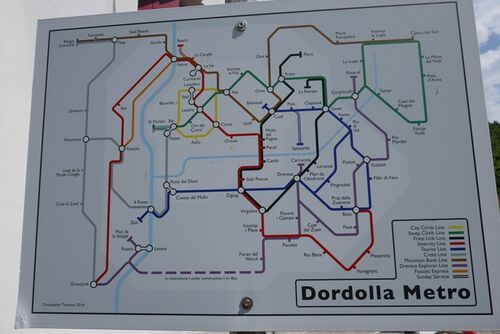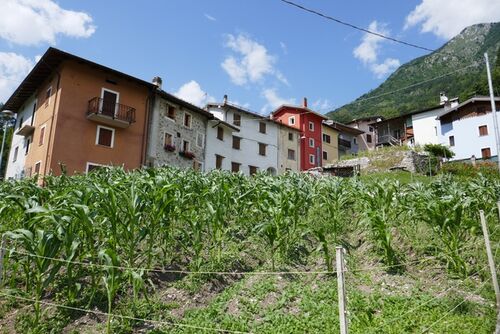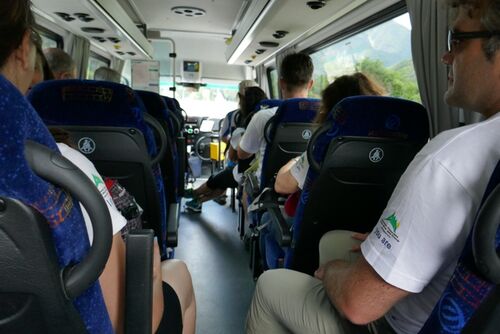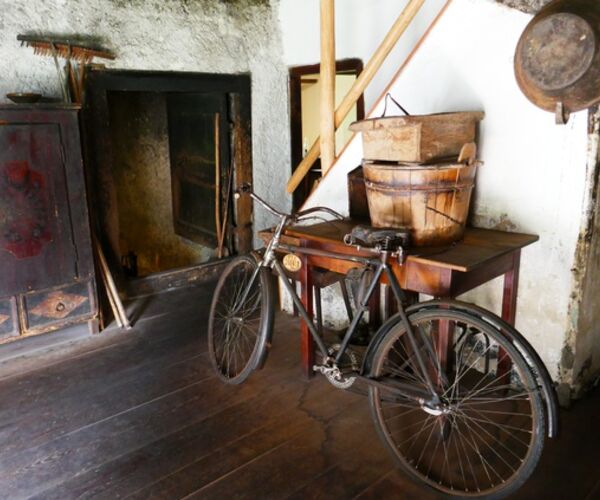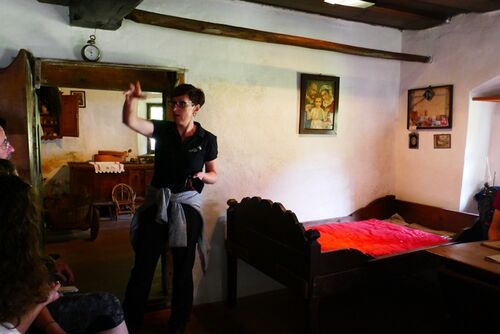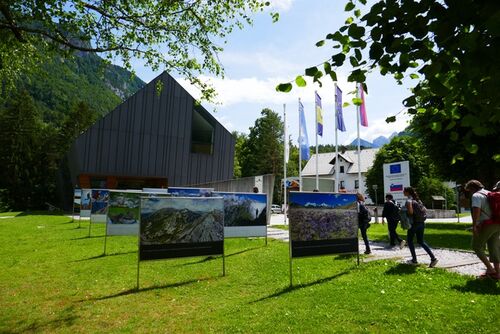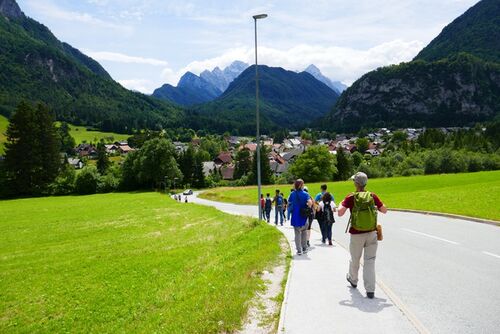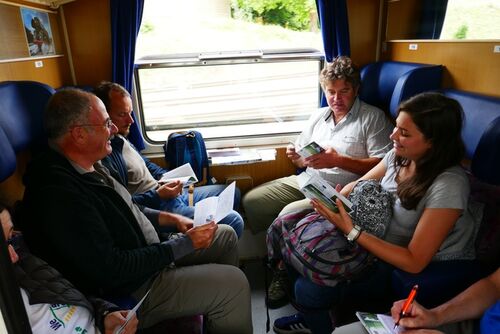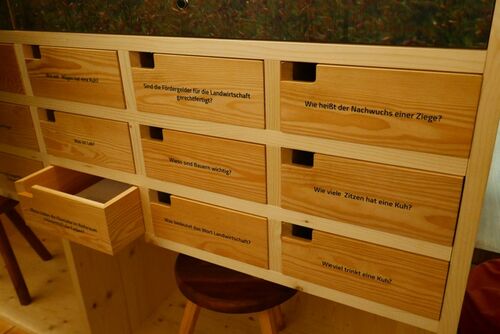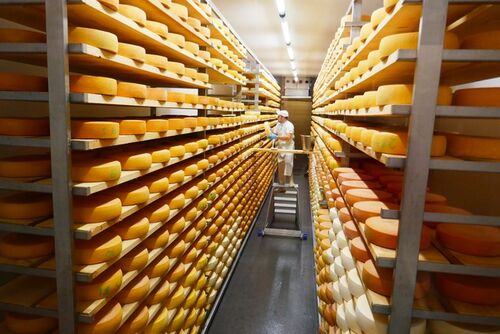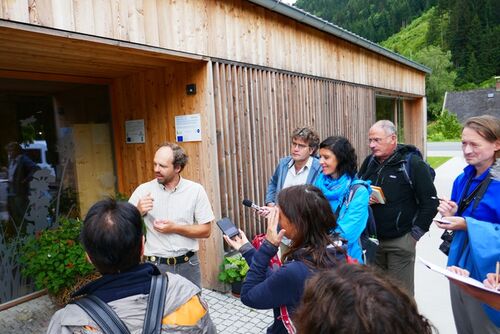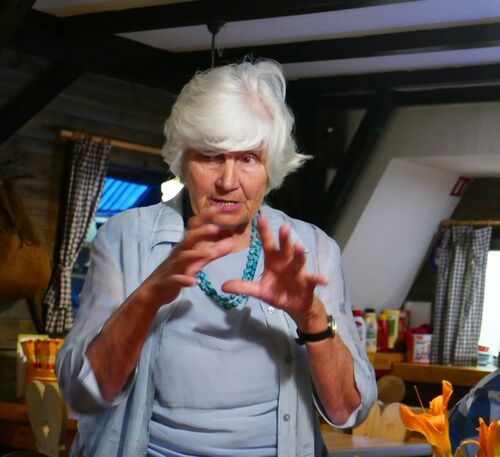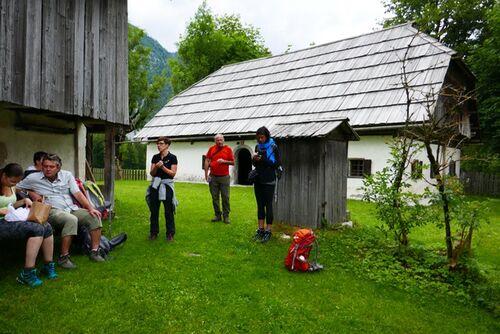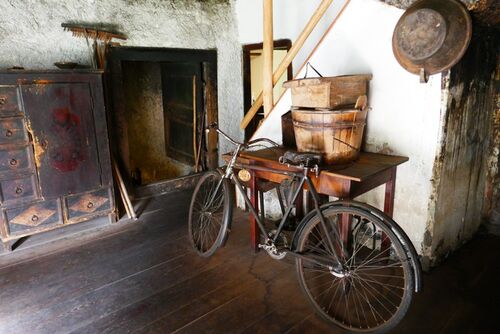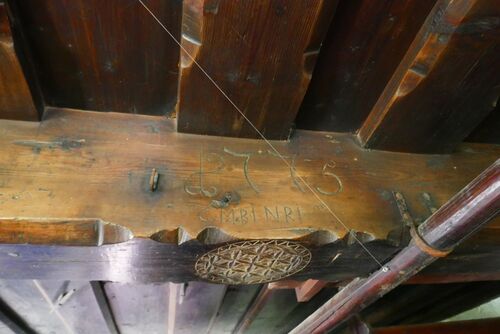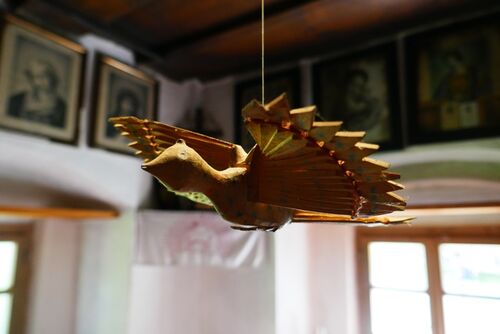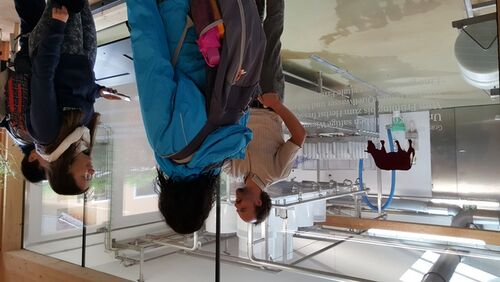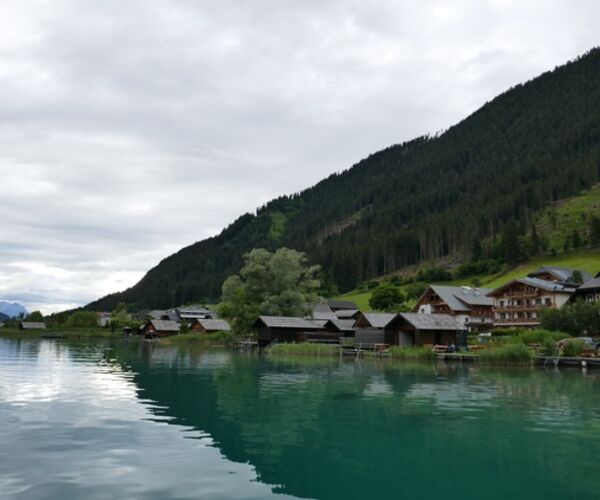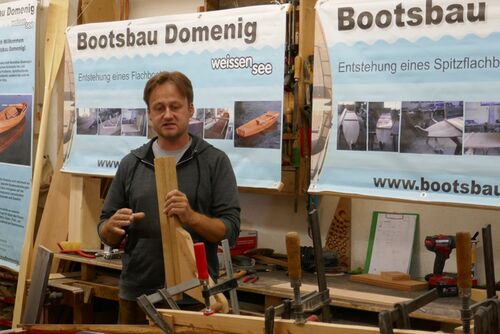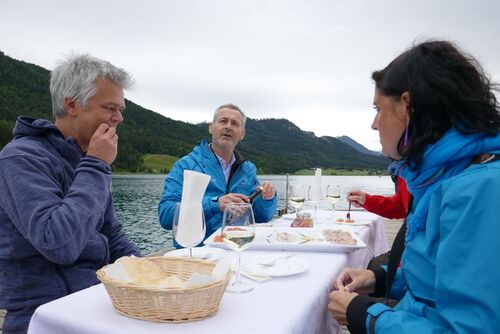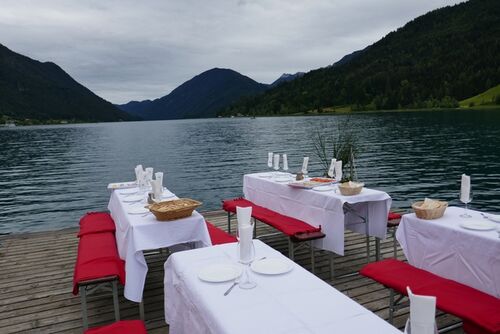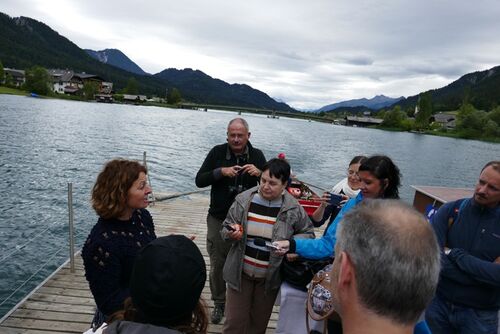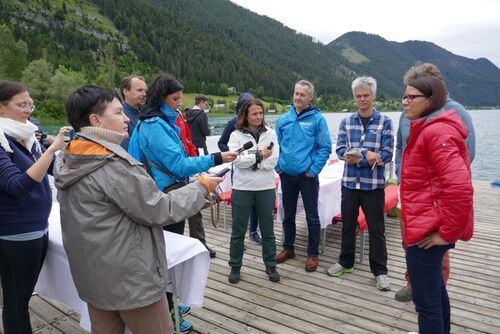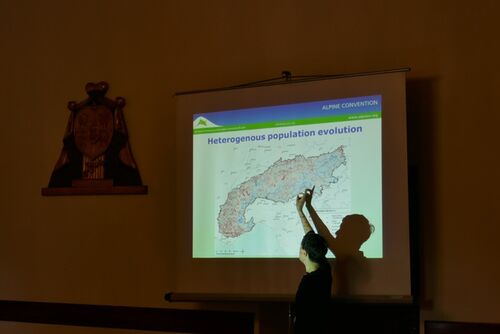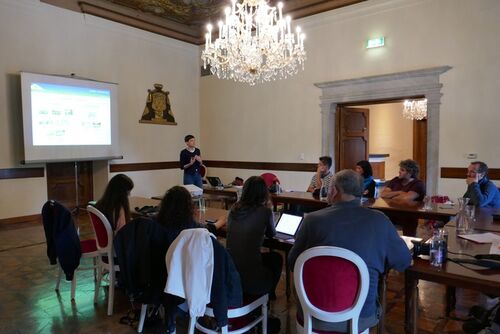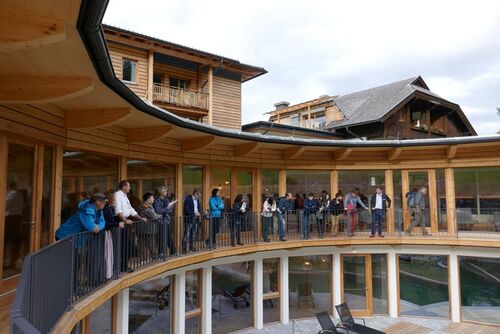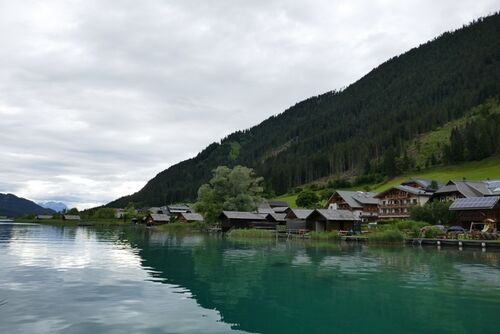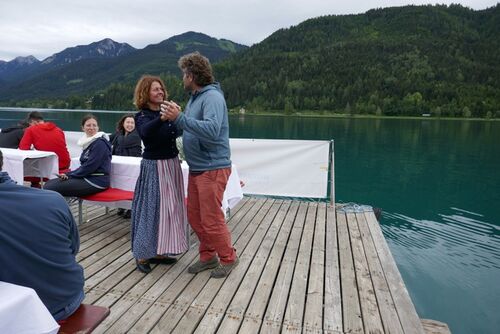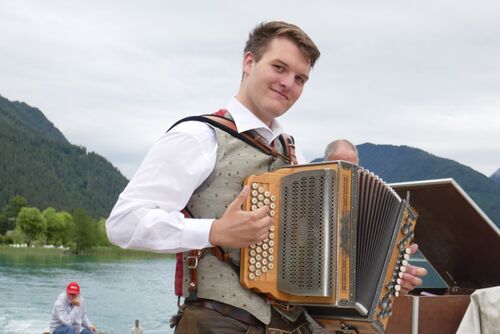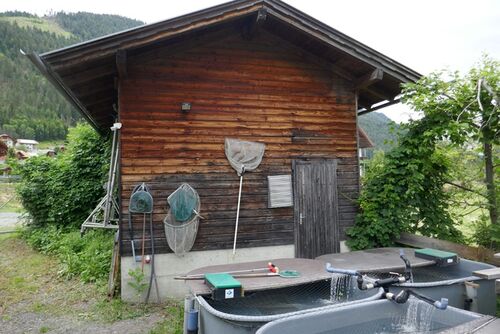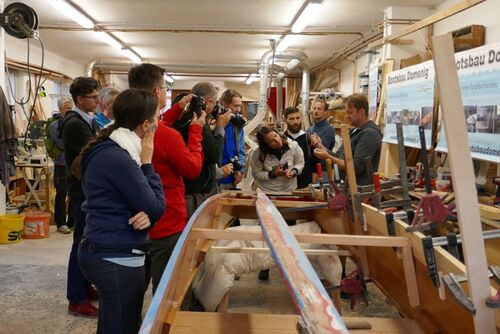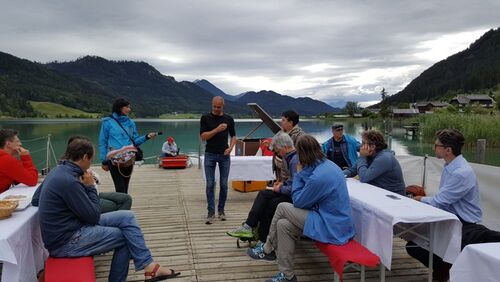We are Alps Tour 2018
Population and Culture in the Alps - Then and Now
The 5th edition’s focus was on the topic of population and culture in the Alps – then and now. The participants experienced activities linked to demography, architecture, languages, Alpine traditions, handicrafts, food and much more!
The small group of selected journalists traveled using sustainable means of transport: trains, buses and bicycles were used and a part of the tour was done on foot. The tour took place from 28 June to 1 July 2018 and crossed three countries on a route linking Carinthia (AT), Gorenjska (SI) and Friuli-Venezia Giulia (IT). Have a look at the programme, participants's profiles and links to our many partners.
The tour led to the release of the following articles and broadcasts by the participating journalists:
Blog
written by: Simone Bobbio
3 Italians, 3 Germans, 3 Slovenians, 1 Austrian and 1 Swiss meet in the Spittal an der Drau train station to head off discovering the Alps. Reading these opening words might make you think this is a joke. But in fact it’s not, because the 11 people we are talking about are all journalists, from some of the most prestigious media all over Europe, who are leaving for an intensive 3 day trip through Carinthia (Austria), Slovenia and Friuli (Italy) with the goal of learning about the populations and culture of the Alps, then and now. The framework they are moving in is We are Alps, a project born 5 years ago within the Alpine Convention for a better circulation and promotion of its “core business”: the protection and sustainable development of the most important mountain region in the heart of Europe.
The Alpine Convention is an international treaty between the Alpine Countries (Austria, France, Germany, Italy, Liechtenstein, Monaco, Slovenia and Switzerland) and the European Union for the protection of the Alps, the natural, cultural, living and economic environment for more than 14 million people and an attractive tourist destination for approximately 120 million guests every year thanks to biodiversity, water and wood reserves and culture. Every year the We are Alps tour has concentrated on a different topic concerning the Protocols or other areas of activity of the Alpine Convention. For the 018 edition, the topic chosen focuses on cultural and social issues in the Alps as stated in the Declaration on Population and Culture adopted by the Convention in 2006 in addition to the Protocols.
After a brief introduction on the Convention and the tour, the journalists took off for the first destination of the trip. By train - obviously - because a healthy development of the Alps starts from sustainable means of transportation. Weissensee is one of the highest lakes of Carinthia, placed in the heart of a Naturpark. It is a very interesting laboratory of integration between tourism and agriculture, natural protection and economical opportunities for the inhabitants. Almut Knaller (vice mayor of the Weissensee community) invited everyone aboard on the particular raft which was traditionally used by the farmers to cross the lake from the villages to the fields with hay carts and horses. It is an original way for tourists to come in touch with the culture of the lake and to observe from a central position the beauties of the surroundings. It floats among little boats of fishermen quietly preparing their poles. Fishing activities represented one of the most important economical resources of the lake because its specific environment still allows a rich biodiversity to survive.
Martin Müller is a fisherman and at the same time a guardian of this asset. He is the living demonstration that it is possible to use natural resources without damaging the ecosystem. As well as catching trout and pikes to sell to the local restaurants, he is committed to the preservation of the lake’s environment through a careful statistical count of the fish and through the reintroduction of the autochtonous types of lake trout which he farms in special pools before letting them free in the Weissensee waters. His method is entirely scientific, but still offers continuous challenges for the wellbeing of the lake’s health and for the wellbeing of the communities that live on its shores.
Another positive example of the interaction between population and environment is the artisanal company Bootsbau Domenig where wooden boats are built using the trees that grow on the lake shore. The company is two generations old and was born to build and fix the boats of local fishermen. Its business and knowhow grew until it now exports boats throughout Europe because the skills of its workers are a very rare heritage.
Getting to know the local community of Weissensee and those who run businesses on the lake shore was the best way to see a positive example of integration between traditional culture and contemporary challenges to keep the communities alive respecting the environment and its specifics. Being inside a Naturpark guarantees that the population is working in tight contact with the officers who are in charge of protecting the ecosystem.
What new adventures will tomorrow bring?
written by: Simone Bobbio
“The ministers of the parties to the Alpine Convention hold the conviction that the value of the Alpine area lies in its diversity. They are therefore committed to preserving and promoting cultural diversity in the Alps as well as to building bridges and fostering dialogue between cultures. The ministers recognise the right of the inhabitants of the Alpine areas to live in these areas on a permanent basis and to engage in economic activities there. They also recognise the right of Alpine residents to equality of opportunity, both within the Alpine region as well as in relation to the residents of non-Alpine areas”.
This quotation has been drawn from the Declaration on Population and Culture adopted in 2006 by the Alpine Convention. It is the leading theme of We are Alps 2018 with, in addition, the subtitle “then and now”. These last two words are essential for the 11 journalists participating in the trip because it gives the perspective to find the cultural differences among the populations living in the Alps, but can provide the common background unifying societies all along the alpine arch.
On the second day of the trip, the subject was illustrated in relation with the opportunities of settling economic activities in the alpine territory. The journalists started off in Radenthein (Carinthia) visiting a small local dairy called Kaslab’n. It is an excellent example of tradition and modernity melting together in a contemporary interpretation of economy. Men and women in the Alps have been transforming milk into cheese for thousands of years. What is new in the Kaslab’n experience is the experimentation of new ways of adapting to the context we live in today. Kaslab’n for example is a cooperative owned directly by 15 small farmers who produce – first of all – milk from their cows, goats and sheep. Their goal is to produce good quality cheese and obtain a better price for their milk compared to the free market quotations.
As they explain simply but effectively, they want to transmit a positive and modern outlook on their job to their children in order to interrupt the flow of young and educated young boys and girls who leave the mountains to look for better work in cities. “We need to modernise the job of farming – said Michael Kerschbaumer, president of the cooperative – so that they can go out to study in the cities knowing that they can come back anytime to start businesses with the resources offered by the homeland”. The main strengths of Kaslab’n are the exclusive use of organic hay to feed the cows, a constant attention towards the quality of their products, a modern and attractive dairy with shop where they produce and sell their products and promote their seducing philosophy.
After two bus, two train rides and one hour walking, the group made a stop at the Slovenian Alpine Museum, which is also running an Infopoint of the Alpine Convention and where they visited the exhibition on mountaineering. Then the afternoon was dedicated to the discovery of traditional farming in Slovenia. Inside the Triglav National Park – along the Radovna Valley which runs from the summit of mount Triglav to Mojstrana – there is a wonderful museum called the Pocar Farmhouse. It is a traditional Slovenian farmhouse which became an invaluable witness of the way people lived in the area when the owner, Minck Pocar, died in 1991 leaving no heirs. Since Minck and her brothers had been living in a very traditional way, the administration of the Park decided to buy it and restore it for museology purposes, simply leaving it as it was left by the owner.
In comparison with Kaslab’n dairy, it represents the opposite face of the same medal. The Pocar family introduced electricity and running water only near the end of their life and in a small part of their farm. Although quite wealthy, they have always refused the introduction of machines and technology to help them in their work. Mojca Smolej, who is responsible of the museum for Triglav National Park showed the house in its entirety: “We found documents that made us think that the house was built in this way before 1609 and was owned by the Pocar or Potzer family since 1672. So now it really looks like it may have appeared more than 300 years ago. We must imagine that the only heated room was the living room and that the cooking took place in the so-called black kitchen, a room entirely built in stone because an open fire was lit inside without any chimney for the smoke. The valley where it lies is very cold, with difficult conditions for growing fruit and vegetables. This is why the main occupation of the Pocar family was farming animals (cows, sheep, goats, pigs, chickens) and working intensively for the two summer months in order to gather enough food for themselves and the animals for the remaining 10 months of the year”. An interesting aspect is to see the neighbouring farms where families still live and work, interpreting in a modern way the traditions of farming in this land.
Are some of you wondering how the journalists managed to travel comfortably despite the complicated timetables of Slovenian public transport? Easy, they used an instrument which has become fundamental for tourists in Slovenia: the “Timetables in the Alps”! It is a booklet edited every year since 2008 by CIPRA Slovenia with all of the schedules of public transport that can be followed around the country. It has been a big effort for the NGO who is also an observer in the Alpine Convention. But it has helped thousands of tourists to limit their footprint on the delicate environment of the Alps.
During the dinner, the discussions were animated by Blanka Bartol from the Slovenian Ministry of the Environment and Spatial Planning, Head of the Slovenian Delegation to the Alpine Convention and by Dušica Kunaver, publisher and story-teller. After some serious talk about environment issues and Alpine protection, Dušica told some fascinating goodnight stories from the Slovenian tradition, including those about Kekec, the little shepherd living extraordinary adventures among pastures and mountains. Everyone had a wonderful night’s sleep with lots of dreams.
To be continued… tomorrow.
written by: Simone Bobbio
Two sides of the same coin characterised the 3rd day of the We are Alps tour. In the previous days, the 11 participating journalists had already tackled the not-so-easy confrontation between tradition and innovation regarding alpine populations and their ways to live the Alpine environment. But today it clearly appeared that visions regarding the past, the present and the future of communities can differ widely, not only from country to country – or region to region – but within a single village.
After heading off from Kranjska Gora by bicycle, the group stopped just short of the boundary with Italy in the village of Rateče where they were challenged by a full immersion into Slovenian tradition using their ears, eyes and especially hands. The first stop of the day was animated by the representatives of the Development Agency of Upper Gorenska and local associations participating in the project AlpFoodway, a cross-disciplinary, transnational and participative approach to Alpine food cultural heritage. 14 partners from 6 Alpine countries, counting Universities, research centres, parks and associations are working on developing an inventory of the Alpine intangible food heritage with the prospect of having it recognised by Unesco. At the same time they are studying commercial valorisation perspectives of these products, believing that heritage can be a source of development. The whole project is funded within the Interreg Alpine Space Programme of the European Union.
To literally have a better taste of AlpFoodway in its Slovenian version, the participants joined the local population in preparing Rateški Krapi, one of the most valuable and traditional dishes of Rateče. They are big “ravioli” made of potato dough, filled with cottage cheese and tarragon in the savoury version and polenta and dry pears in the sweet version. Everyone had a chance to dig their hands in the traditions and taste a bite of what farmers normally ate in the fields.
After a wonderful bike ride along the ancient railway transformed into a cycle path they reached Tarvisio and then, by bus, the village of Dordolla in the Aupa valley. Undoubtedly, crossing the Alpine chain from north to south represents a big change of perspective in the landscapes, in the weather and in the social aspects. After the Carinthian economic vitality and the Slovenian vivid traditions, Dordolla welcomed the journalists with its relaxed atmosphere. Probably too relaxed, since the population of the village is constantly decreasing and now counts only 40 inhabitants where 400 used to live. But probably something is changing in these deserted Udinese Prealps if a young Austrian farmer decided to establish his family, home and farm in Dordolla.
“I ended up here – explains Kaspar Nickles – because I fell in love with my wife whose family came from Dordolla and I fell in love with the region where I knew I could apply my University studies in farming. We moved here 13 years ago, but I never would have imagined the challenges I had to face during this time”. Kaspar started his business alone with the wish to work the land and live from it, but, quickly recognised that he also needed to have a tourism activity. “Most of the pastures, fields and forests surrounding Dorolla lay abandoned for years and years and made the area absolutely unattractive for any visitor coming from outside. Most of the inhabitants of Dordolla are retired or work in the nearby city of Moggio: no one had any vision of development or future for the area. I chose to start a new farming activity here but, due to the topography and also the land-ownership structures in the region, this alone cannot sustain a family. On the other hand, farming is the only way to attract tourists, who are interested in visiting a beautiful and well preserved landscape, in trekking through well kept pastures and forests and tasting the local products. Parallel to the farming activity, with my wife we opened an Agriturismo that allows us to earn enough money to live decently and guarantee a future to our three children. The environment of the region underwent extreme pressure when over 400 people lived here, then it was completely abandoned. I believe that an extensive and respectful farming activity is the only way to attract services and other forms of business”.
A few years after Kaspar, another foreign person decided to settle in Dordolla. “Dordolla is where I keep my books – quotes Christopher Thomson, a London born filmmaker who settled here eight years ago . My job takes me all around the world for long periods of the year, but here is where I call home”. Recently Christopher presented a well appreciated film titled The New Wild – Life in the Abandoned Lands, set and entirely shot in Dordolla. It is a poetic vision on abandonment and depopulation and on how a village and its nature can attempt to survive and come back to life through the cracks and debris. Kaspar the farmer, Christopher the artist and most of the Dordolla population have been organising and animating a cultural festival that has brought to the small village artists and public from all over Europe. It has become the highlight of the region although it was born spontaneously and its animators have never looked for promotion nor publicity. “The festival was born almost casually – continues Christopher – when some inhabitants of Dordolla decided to start cutting the grass again in the pastures around the village to avoid the risk of forest fires. But what could they do with the hay that was gathered? Make bales and place them in the piazza of the village for people to sit on during an artistic gathering! For nearly 15 years, before I even got here, this has been the philosophy of our festival and things will not change in the future. We actually realised that in last year’s edition we reached the maximum amount of people Dordolla can sustain. We shall carry on in this way, where everybody helps in everything, from the artist, to the bar-owners, to the organisers, to the visitors”.
Will revaluing tradition lead to innovation? Or will innovation grow from the ruins of tradition?
written by: Simone Bobbio
Can we consider the Alpine region a “melting pot”? On the 4th day of the We are Alps tour, the experiences encountered on the field by the group of journalists were focused on the small cultural and linguistic enclaves that characterise the territory. The final destination of the tour was Val Resia, an Italian valley within the Friulan Prealps where a population of few hundreds of people still speak a dialect descending directly from the Slovenian language – or, since views differ on this, a language of its own, sharing the same roots as Slovenian; in any case, very similar to it. It is only one example of the various linguistic and cultural minorities that have spread centuries ago all along the Alpine arch, showing that National borders are simply a very late concept.
In Val Resia, Rosajanska Dolina in their dialect, the issue of conserving and protecting the local cultural heritage had a major turning point in 1976 after a strong earthquake destroyed most of the villages and buildings of the valley. As the locals say, it was year 0, the historical moment in which it was time to rebuild not only houses, but a cultural heritage as well. Representatives of the Museo della Gente della Val Resia, the Ecomuseo Val Resia, the Val Resia Folk Group and the Municipality of Resia explained and showed the activities of a very lively group of people that are trying to conserve their language and traditions through music and dances that are performed all over the world.
Exceptionally, a dance lesson was held for the members of the We are Alps tour. This is very uncommon because local children do not need proper lessons as they suck the steps and the rhythm directly from their mother’s milk…
The counterpart of such a crisp cultural vitality is a phenomenon widely spread in the Alps: depopulation. Protecting the traditional heritage is difficult when most of the young people leave their valley for work reasons. This is why the Julian Prealps Nature Park has recently established a Youth Advisory Board which is working on advocating issues coming from 18 to 30 year old Resians who are still investing time and resources in their native valley. As Stefano Santi - Director of the Park - mentioned, a park’s mission is not only preserving the animal and vegetal species, but the human specie as well.
Practically and symbolically, the theme of cultural minorities closed this year’s We are Alps tour dedicated to Population and Culture – Then and now. It is probably the most delicate issue for the people living in the Alps to tackle, because it represents the most intangible – and important as well – aspects of a community who needs to recognise itself through history, language and traditions. It is not measurable like biodiversity, economy, gastronomy or demography. But it affects all of them altogether.
The last paragraph of the introduction to the Declaration on Population and Culture of the Alpine Convention states the following: “The ministers are aware of the effects of demographic change on living and working conditions in the Alpine areas and commit to the following aims and principles which will be implemented through the exemplary measures set out in the annex to this declaration within the framework of the applicable national regulations and based on the available resources”.
Please take the time to read the Declaration as a whole and reflect upon it, in the light of the experiences related in this blog.
Partners
Photogallery
Participants
written by Monica Bonetti:
- In Carinzia sul lago bianco (Weissensee) - RSI
- Alpinismo in Slovenia tra miti e leggende - RSI
- Tra spopolamento e nuove opportunità in Carnia - RSI
written by Giulia Negri:
written by Veronika Gnezda:
written by Stefano Ardito:
- Là dove passava il treno ora si pedala in sicurezza - Il Messaggero
- Il punto sulla Convenzione delle Alpi, intervista a Markus Reiterer - Montagna.TV
- We are Alps - Plein Air
written by Dušan Malovrh:
- Pr' Pocar se je čas ustavil - Slovenske novice
- Zverinica iz Rezije - Slovenske novice
written by Vida Petrovčič:
- Prihodnost v sožitju jezikov in kultur - Planinski vestnik 11/2018
- Slovenija - med industrijo in turizmom - Planinski vestnik 10/2018
- Rešitve ohranjanja narave in delovnih mest - Planinski vestnik 09/2018
- Sredin gost: Dušica Kunaver - RTV4
- Sredin gost: Luigia Negro - RTV4
written by Jochen Bettzieche:
- Alpen mit Mehrwert - Stuttgarter Zeitung
- Heidi-Style - Süddeutsche Zeitung
written by Axel Klemmer:
- Wer will hier leben? - Bergsteiger 10/18
- Gehen oder bleiben? - Panorama 5/10
written by Simone Bobbio:
- Il seme di Dordolla - in movimento 12/18
- Le Alpi siamo noi - Montagne360 09/18
written by Dr. Georg Bayerle
- Naturnähe und Nachhaltigkeit inmitten der Gailtaler Alpen, Bayerischer Rundfunk
- Podcast Der Naturpark Weißensee in Kärnten, BR Mediathek
- Neue Wildnis im Friaul
- Reisegeschichten über die wilden und hässlichen Seiten der Alpen
by Wilma Pradetto
- Documentary series "Alpendörfer" - ServusTV
Reports by other media
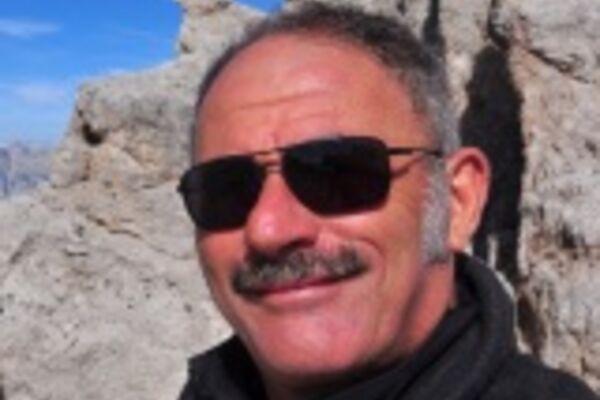
Stefano Ardito
Many years ago I started discovering the Alps (and the Apennines, the Himalayas and other mountain chains in the World) as a mountaineer. Now I describe them as a journalist, a filmmaker and a writer, I never stopped exploring them by car, on foot or on my skis, and I never stopped enjoying myself while doing so. It is incredible, every time, to discover the natural and human biodiversity of the wide arc of mountains that links the Côte d’Azur with Slovenia. The main themes of my work have always been trekking and mountaineering, wildlife and National Parks, history and local traditions. In the last years I wrote often about the Great War 1914-1918, and her impact on the Alpine valleys which we will cross soon.
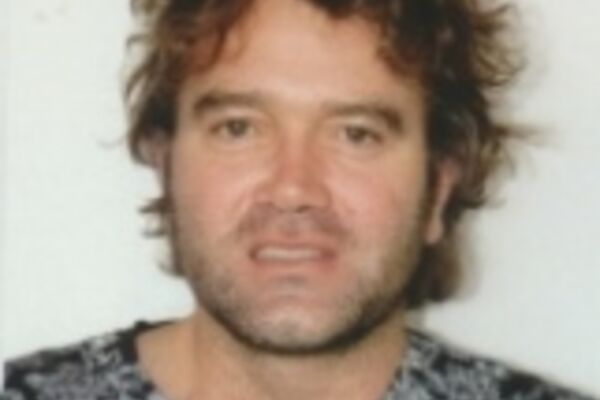
Georg Bayerle
Dr. Georg Bayerle, born in Günzburg, Bavaria. Specialist for Mountains and Environment in Radio and television of Bayerischer Rundfunk. Studies in München and Wien, PhD in Literature at the University of Köln. Since the age of five he has been connected to the mountains and continuously on tour all around the year. His reports are broadcasted in shows like "Rucksackradio", "Bergauf Bergab" und "Zwischen Spessart und Karwendel". He published more than 100 films and numerous radio reports about mountains, Alpine culture and nature. Many of the broadcasts show the transformation of Alpine nature caused by economic impacts as well as climate change. The reports observe the changes in the relations of humans, mountains, and civilisation as well as remarkable incidents of Alpine cultural history.
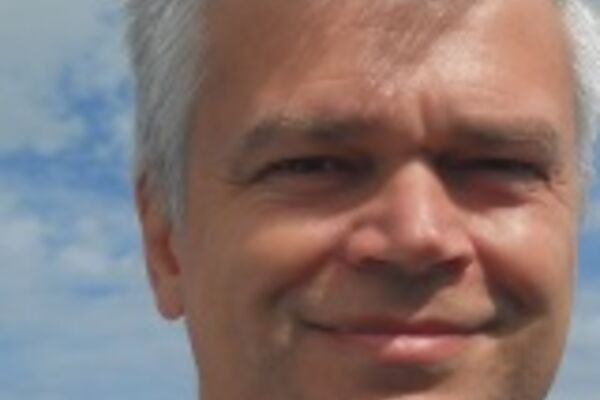
Jochen Bettzieche
Jochen Bettzieche is a German freelance-journalist specialized in economical, technical and scientifical topics. One of his main topics is sustainability which he covers since 1999. He works for newspapers like Neue Zürcher Zeitung, Neue Zürcher Zeitung am Sonntag, Süddeutsche Zeitung and Stuttgarter Zeitung, magazines like Schrot & Korn and Cosmia and special interest magazines focused on economics or renewable energies. In addition to his work as a journalist he produces surveys, takes part or moderates panel discussions and gives speeches and advises companies about sustainability-issues. Jochen Bettzieche a physicist with postgraduate studies in journalism.
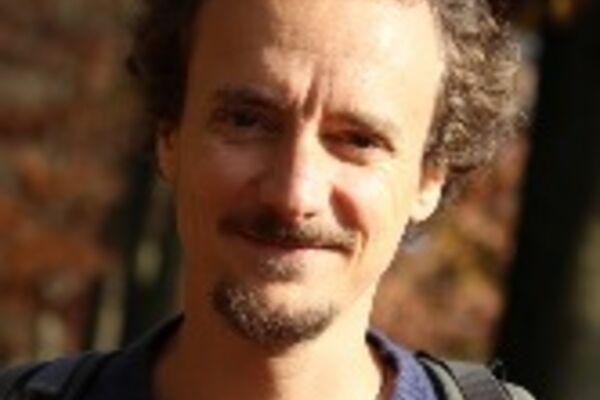
Simone Bobbio
Free-lance journalist, living and working in Torino, Italy. Communication officer for the mountain rescue corps of the Piemonte region (CNSAS Piemonte), he has been professionally writing about mountains since 2005 collaborating with Italian and French magazines (Alp, Meridiani Montagne, Montagne 360, Montagnes Magazine, Rivista della Montagna, Slow Food, Vertical), newspapers (La Stampa, Il Manifesto), radio (Radio Flash, Radio Beckwith Evangelica), and television (Alpchannel). He likes to deal with problematic issues regarding sports, culture, politics, economy, tourism and environment. Through his historical background he is interested in studying the traditional aspects of Alpine societies and their contemporary interpretation which will guarantee a new life for the Alps.
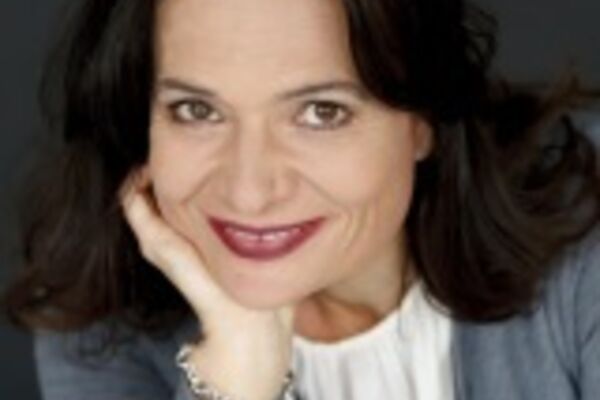
Monica Bonetti
I started working at RSI (the State Swiss Radio for Italian speaking people) when I still was in Highschool, for a radio program completely realized by young people. After graduation in Arts and literature in Milano I lived shortly in Paris and London then I came back to RSI, in the TV news department. In 2001 I was in the team who launched the rsi website, before coming back to TV and radio program for the culture department where I am currently the presenter of the fine arts programme broadcast every Sunday on RETE DUE, the cultural channel of RSI.
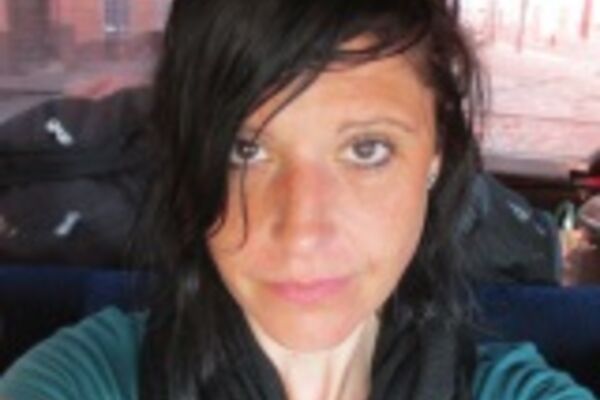
Veronika Gnezda
Veronika Gnezda was born in 1979 in Ljubljana. She studied philosophy at the Faculty of Arts in Ljubljana. In the meantime, after a successful invitation for tender on the public broadcast system, Veronika began working for the National Radio Slovenia, on one of its most popular programmes – Channel 2, Val 202. Now she is a member of its permanent staff, covering social and human-interest issues. Her work requires a wide range and knowledge of media culture, audio and visual art and social events in general. She is an editor of the radio show called Noah band, show about environment, biology and animals. She lives in Ljubljana, Slovenia. She doesn’t have her own family, but she is the best aunt on the world.
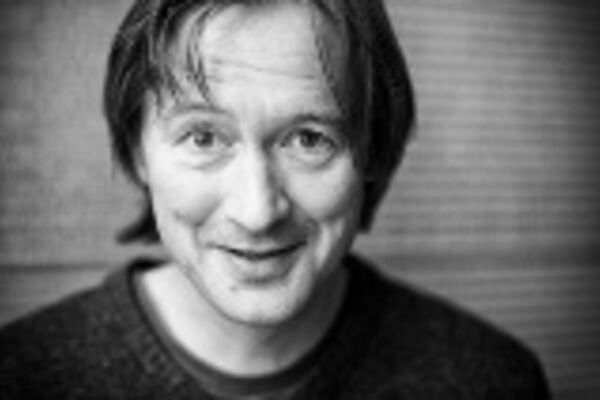
Axel Klemmer
Axel Klemmer, born 1963, is geographer and has worked as editor, journalist and author for special interest magazines, travel books, TV and DAV (German Alpine Club) since the mid-1980's. Collecting high summits in the Alps, once essential, has become less important for him. Visiting the mountains means social studies about interaction, misunderstandings and clichés between the people who come there for fun and those who live and work there. What does wealth mean – and how does it look: This is the question that currently keeps him going on.
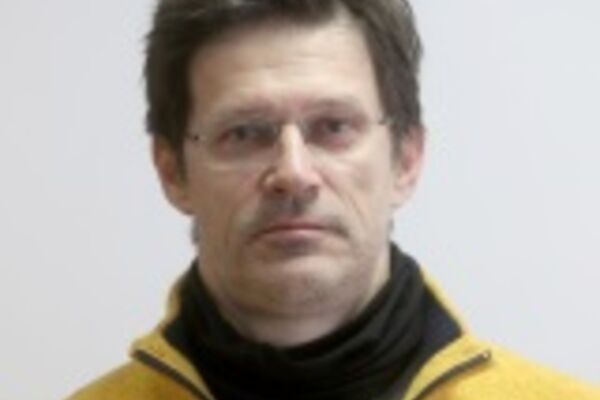
Dušan Malovrh
Born in 1966, studied philosophy and sociology of culture at the University of Ljubljana. I have been working for the last 25 years for the Slovenian daily newspaper Slovenske novice, based in Ljubljana: first as a sports journalist and editor of sport, then covering general issues. I also worked on launching the digital edition of our newspaper online (slovenskenovice.si), after that I was executive editor of Nedeljske novice (Sunday edition of Slovenske novice and its supplement Plus). The last five years I have been working as desk editor in Slovenske novice and also as the editor of Turistična tribuna (articles on tourism). I am a member of the Slovenian Society of Tourism Journalists.
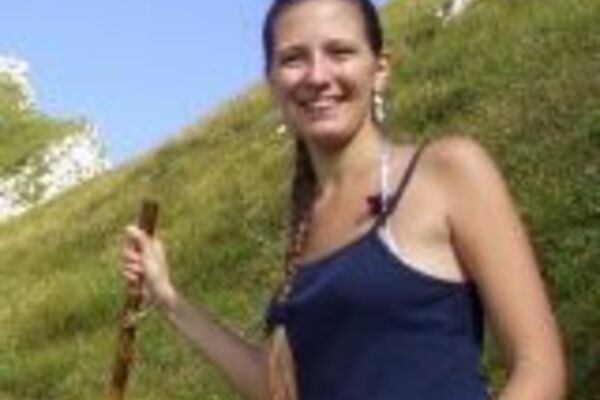
Giulia Negri
28 years old, science communicator, animal lover, book devourer. After graduating in Physics, I deepened my knowledge in communication and journalism during the Science Communication Master “Franco Prattico” at SISSA, in Trieste. I worked at CERN (Geneva), in educational publishing and in science event organising. At this moment in time I am writing and videomaking as a freelance for OggiScienza and Rivista Micron, Italian newspapers which report about science, research, environment and latest news. I love mountains, both in winter - I am a skiingaholic - and in summer: I really enjoy their silence, and their ability to make you feel different every time you reach the summit.
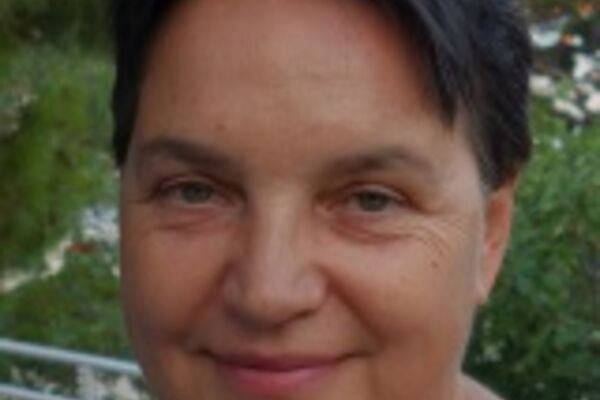
Vida Petrovčič
Vida Petrovčič is a renowned Slovenian television journalist and commentator covering economics, monetary policy, public finances, banking, energy production and policies, trade, privatisation and all other transitional topics of Slovenian economy. She covers these and other topics also for paper media. She has also played a prominent role as a reporter during the Slovenian war for independence. About the Alpine Convention she is writing for the Slovenian Alpine Magazine.
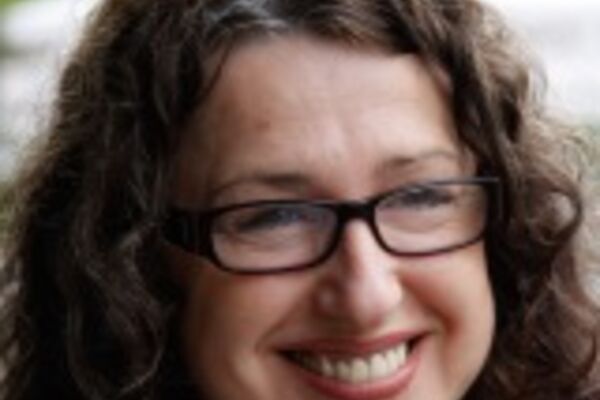
Wilma Pradetto
I am a freelance filmmaker, born in Graz, Austria. Growing up in a small village in the southern part of Styria. Moved to Berlin to study at the Deutsche Film- und Fernsehakademie Berlin. Since that I commute between two worlds and work as a documentary-film director for ARD, ZDF, arte and Servus TV. I am a curious person, always interested in people and their stories. My new project tells of everyday life and traditions in the Alps and how you get a mountain-village into the future.



















